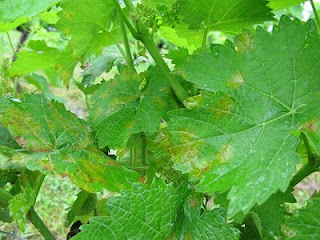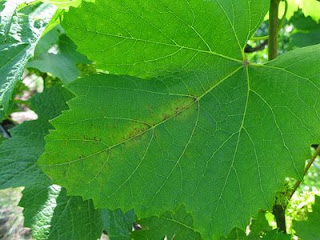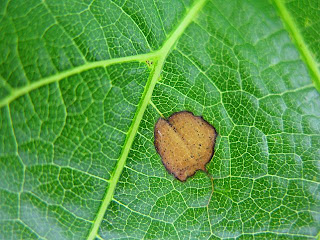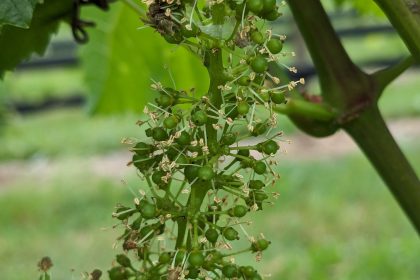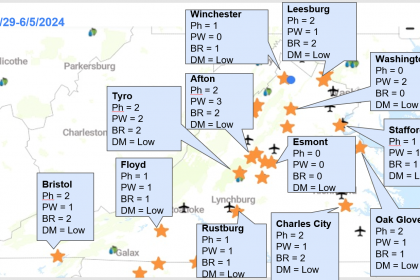Thank you for those of you who made to the meeting at White Hall. My handout can be downloaded from the previous post.
The rain is gone for now, and in the last three days, we had about 1.2 inches of rain, and wetness event lasted over 68 hours with average temperature of 58F. As you can imagine, it was good for Phomopsis, black rot, and downy mildew infection, and powdery mildew ascospore discharge. In addition, we had three consecutive nights with temperature above 55F which promote downy mildew sporulation.
We are expecting even more rains next week. If you are in the same situation, please be prepared. Depends on when you applied the last application, what chemical you applied, how much rain you received, which variety you have, and the history of your vineyard, the situation will be different. However, it is blooming-postblooming time when the all major fungal disease can cause damages to your vines. I’m not an advocate of the intensive management, but these series of rain (including incoming ones) may not give you an option. Please spend some time to make an assessment of the situations in your vineyards.
Here are some of potential scenarios.
1) Last application: two weeks ago, mancozeb + sulfur (or similar protective fungicides), vines are in bloom or post-bloom, little or no rain, expecting rain this week –> You will have a wide range of choices. You may stick with economical protective fungicide (e.g. mancozeb + sulfur).
2) Last application: one week ago, mancozeb + sulfur (or similar protective fungicides), vines are in bloom or post-bloom, little or no rain, expecting rain this week –> Here comes a judgment call. If you did not experience rain in the last week, you may able to wait until next series of rain is over and hit vines with curative fungicides (Ridomil or Phosphorus acid for downy, Rally for black rot, etc) plus a broad spectrum protective fungicide such as mancozeb products.
3) Last application: two weeks ago, mancozeb + sulfur (or similar protective fungicides), vines are in bloom or post-bloom, had 2-3 days of rain, expecting rain this week –> Downy mildew and black rot might be your major concern. Consider using products with curative activities (Ridomil or Phosphorus acid for downy, Rally for black rot, etc) plus a broad spectrum protective fungicide such as mancozeb products.
4) Last application: one weeks ago, mancozeb + sulfur (or similar protective fungicides), vines are in bloom or post-bloom, had 2-3 days of rain, expecting rain this week –> Downy mildew and black rot might be your major concern. Depends on how much rain you received, the protection from mancozeb and sulfur may be gone by now. Consider using products with curative activities (Ridomil or Phosphorus acid for downy, Rally for black rot, etc) plus a broad spectrum protective fungicide such as mancozeb products.
5) Last application: one weeks ago, Ridomil+ sulfur (or similar systematic fungicides), vines are in bloom or post-bloom, had 2-3 days of rain, expecting rain this week –> Ridomil should provide you a coverage for 10-14 days. However, consider the history of your vineyard and current situation. If you had a issue with downy mildew or black rot last year, you may need to be on top of the situation. You can scout your vineyard and look for symptoms of downy or black rot (please see images below). If you find downy mildew or black rot in your vineyard (say, few leaves per vine), then you may need to think about protecting your leaves against the upcoming rain events. If you know vineyards are clean (historically and right now), then you may be able to hold off your application until after the upcoming rain events. Either way, downy mildew and black rot might be your major concern. Consider using products with curative activities (Ridomil or Phosphorus acid for downy, Rally for black rot, etc) plus a broad spectrum protective fungicide such as mancozeb products.
The other disease of concern would be Botrytis. It can cause infection on flowers and cause problems later in the season. You may want to include some of Botrytis materials such as Elevate, Endura, and Pristine in your program. And although I did not mention in the previous scenarios, you still want to protect your vines from powdery mildew. Sulfur would be a nice and economical insurance. If you decided to use other products, such as Sterol-inhibitors, please make sure you rotate the mode of action of the chemical.
Here are pictures of downy mildew and black rot for your reference:
